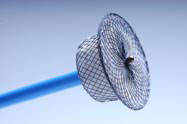INTERVENTIONAL CARDIOLOGY
AND
ELECTRO-PHYSIOLOGY PROCEDURES
Sub-article of the main story "Hearts in Golden Hands"
These are some of the procedures that the eminent doctors’ team from USA did in SSSIHMS, WF in February 2010.
Atrial Septal Defect (ASD) closure
ASDs are abnormal connections between the two upper chambers of the heart (atria) that lead to stunted growth and frequent illnesses. Over time, large ASDs can lead to pulmonary hypertension. Traditionally, these defects were closed by surgical correction via patch repair of the ASD. Now, with ASD closure devices, they can be closed through a short procedure in the cardiac catheterization lab.
 |
Ventricular Septal Defect (VSD) closure
Like ASD, this too is an abnormal connection but between the lower pumping chambers of the heart. VSDs are associated with stunted growth and if pulmonary hypertension develops early, this becomes a fatal condition.
 |
VSD closure devises close the defect through a catheterization procedure instead of open heart surgery.
Coarctation Stent
Aorta is the largest blood vessel that arises from the left ventricle of the heart and supplies pure blood to all parts of the body. Coarctation of the aorta is a condition where a large portion of the aorta is narrowed. This leads to hypertension and stunted growth.
The usual corrective procedure is excising the portion of the aorta that is narrowed and having a shunt that bypasses the narrowed part.
This involves surgery with the incision sometimes extending all the way down to the abdomen. However, with a coarctation stent and angioplasty of the aorta, the narrowing is expanded via a procedure that is done in the catheterization lab – there is no surgery required.
Patent Ductus Arteriosus (PDA) occluders
 |
|
A PDA is a connection between the pulmonary artery and the aorta. This connection exists when the baby is still in fetal stages. The lungs are not exposed to atmospheric pressures and the oxygenation takes place through the placenta.
However, once a baby is born, the lungs begin to function and air enters the pulmonary system (lungs). Normally the PDA closes on its own, but when it persists after birth, it leads to stunted growth and the early development of pulmonary hypertension, which is a fatal condition.
PDAs can be closed using an occlusion (blocking) procedure in the catheterization lab, rather than by a left thoracotomy (open procedure involving incision between the ribs) which is an open heart procedure.
Implantable Cardioverter Defibrillators (ICDs)
When the heart is weakened from prior heart attacks or from unknown causes, the heart is prone to have arrhythmias that lead to death. In addition, there are several genetic diseases (Long QT syndrome and Brugada Syndrome) which cause abnormalities in the rhythm of the heart which lead to sudden death. ICDs work by first attempting to pace the heart out of this dangerous rhythm. If this is not successful, the ICD will shock the heart out of the dangerous rhythm. These devices last 5-7 years before the batteries must be charged.
Cardiac Resynchronization therapy / Defibrillators (CRTDs)
When the function of the heart deteriorates because of pervious heart attacks or from unknown causes, the various walls of the left ventricle beat asynchronously leading to a further deterioration in the functioning of a weak heart. CRTDs are designed to improve heart function by synchronizing the contraction of the various walls of the left ventricle, in addition, these devices have a defibrillator function that shocks the heart out of dangerous rhythms should they occur. These devices last 5-7 years before the battery must be changed.
 |
 |
||
Pacemakers
As patients age, they may develop fibrosis of the conduction system of the heart from the aging process or from heart attacks. In addition, there is a small proportion of patients who have defective conduction systems from birth (congenital heart block).
Pacemakers are devices that provide synchronized electrical impulses to the heart in those with deficits in the electrical system of their heart. Pacemaker leads were brought from USA and the generators purchased in India.
For more information about these Hospitals, please visit www.sssmt.org.in
- Heart2Heart Team





